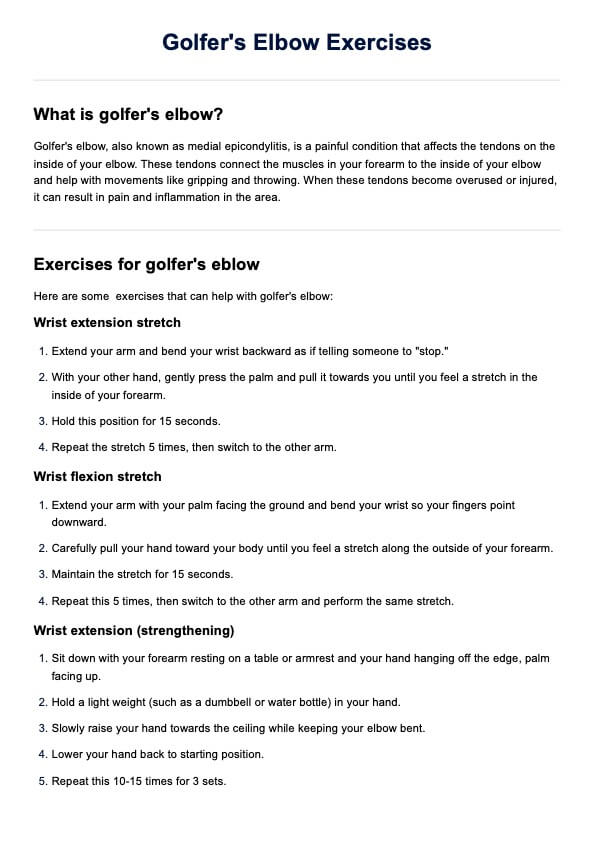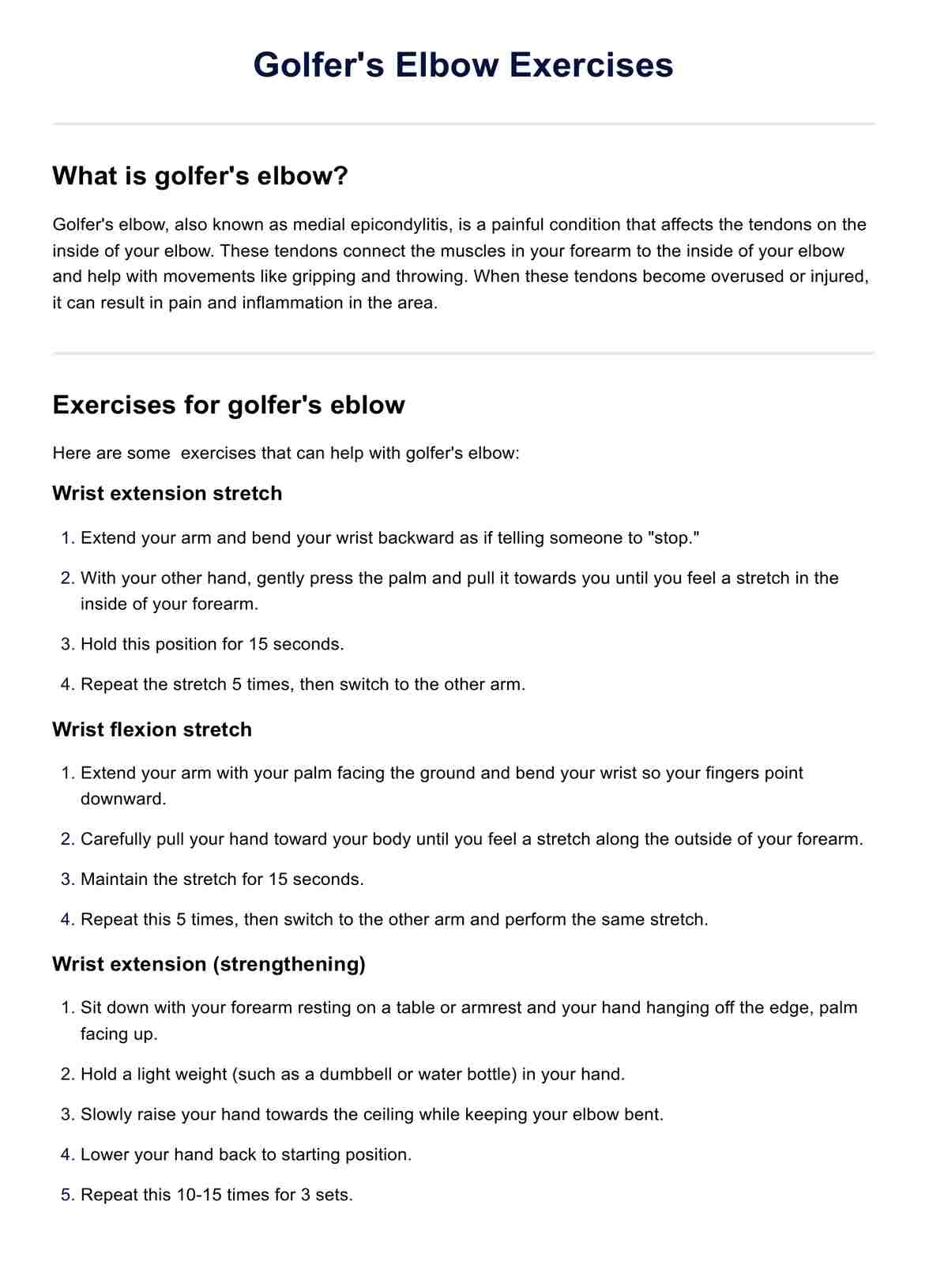Golfer's Elbow Exercises Handout
Discover effective exercises for golfer's elbow in our comprehensive handout designed for healthcare professionals. Download now and improve patient care with Carepatron!


What is a golfer's elbow?
Golfer's elbow, or medial epicondylitis, is a condition characterized by pain and inflammation on the inner side of the elbow, where the tendons of the forearm muscles attach to the bony bump. This condition is typically caused by repetitive stress or overuse of the affected forearm, particularly through motions involving gripping, lifting, or swinging.
Despite its name, a golfer's elbow can affect anyone who performs repetitive wrist and arm motions, not just golfers. Common symptoms of a golfer's elbow include pain and tenderness on the inner side of the elbow, stiffness, and weakness in the hands and wrists.
Golfer's Elbow Exercises Handout Template
Golfer's Elbow Exercises Handout Example
Importance of golfer's elbow exercises
For several reasons, engaging in specific exercises for the golfer's elbow is crucial. Firstly, these exercises help to strengthen the forearm muscles and tendons, reducing the strain on the muscles attached to the elbow and preventing further injury. Strengthening exercises target the affected muscles, improving their resilience and support to the elbow joint.
Secondly, stretching exercises enhance flexibility, relieving tension in the tendons and promoting a better range of motion. Regularly performing these exercises can alleviate pain, reduce inflammation, promote muscle endurance, and expedite healing.
Finally, incorporating these exercises into a rehabilitation program can prevent the recurrence of a golfer's elbow by promoting muscle balance and overall joint stability. This proactive approach ensures long-term recovery and minimizes the risk of future injuries, enabling patients to return to their activities confidently.
7 exercises for golfer's elbow
This section outlines seven effective exercises for golfer's elbow that physical therapists can teach their patients. These exercises stretch and strengthen the muscles and tendons around the elbow, aiding recovery and preventing further injury.
1. Wrist extension stretch
To perform the wrist extension stretch, have the patient straighten their arm and bend their wrist back as if signaling someone to "stop." They should use their opposite hand to apply gentle pressure across the palm and pull it toward them until they feel a stretch on the inside of the forearm. Hold the stretch for 15 seconds. Repeat this stretch 5 times, then switch to the other arm.
2. Wrist flexion stretch
For the wrist flexion stretch, instruct the patient to straighten their arm with their palm facing down and bend their wrist so that their fingers point down. They should gently pull their hand toward their body until they feel a stretch on the outside of the forearm. Hold the stretch for 15 seconds. Repeat this stretch 5 times, then switch to the other arm.
3. Wrist extension (strengthening)
To strengthen the wrist extensors, the doctor should have the patient bend their elbow to 90 degrees and support their forearm on a table with the wrist at the edge. They should straighten their elbow slightly while supporting the arm on the table. Next, they should fully straighten the elbow and lift the arm so the table no longer supports it.
With the palm down, the patient should bend the wrist as far as possible, hold for 1 count, then slowly lower for 3 counts. Begin without weight and increase repetitions until the patient can complete 30 reps on 2 consecutive days without increased pain, then start with a 1 lb. weight, progressing to 3 lbs.
4. Wrist flexion (strengthening)
For wrist mobility and flexion strengthening, the patient should bend their elbow to 90 degrees and support their forearm on a table with the wrist at the edge. They should straighten the elbow slightly while supporting the arm on the table. Then, they should fully straighten the elbow and lift the arm so it is no longer supported by the table.
With the palm up, they should bend the wrist up as far as possible, hold for 1 count, then slowly lower for 3 counts. Start without weight and increase repetitions until the patient can complete 30 reps on 2 consecutive days without increased pain, then start with a 1 lb. weight, progressing to 3 lbs.
5. Forearm supination & pronation (strengthening)
To perform this exercise, the patient should bend their elbow to 90 degrees and support their forearm on a table with the wrist at the edge. They should straighten their elbow slightly while supporting the rest of the arm on the table. Then, they should fully straighten the elbow and lift the arm so it is no longer supported by the table.
Begin with the palm facing the side and slowly turn the palm up. Return to the start position and then turn the palm down. Start without weight and increase repetitions until the patient can complete 30 reps on 2 consecutive days without increased pain, then start with a 1 lb. weight, progressing to 3 lbs.
6. Stress ball squeeze
For the stress ball squeeze, the patient should squeeze the stress ball as hard as possible, hold for 1 count, and then relax. This strengthening exercise should be performed after completing the staged strengthening exercises.
7. Finger stretch
To perform the finger stretch, the patient should place an elastic band around the outside of their fingers and stretch their fingers out against the band's resistance. They should then return to the start position and repeat. This exercise should be performed after completing the staged strengthening exercises.
How to use our Exercises for Golfer's Elbow Handout
This handout is designed for healthcare professionals to provide patients with online guidance on exercises for managing the golfer's elbow. Follow these steps to ensure patients can effectively use the handout.
Step 1: Send the handout
Share the digital handout with your patients through your preferred online platform, ensuring they can easily access the document.
Step 2: Review the handout together
Schedule an online consultation to review the handout with your patient. Discuss the purpose of each exercise and any specific instructions or precautions. Ensure the patient understands the exercises and their benefits.
Step 3: Demonstrate exercises virtually
Use video calls to demonstrate each exercise. Show the proper form, starting position, and the correct number of repetitions. Ensure the patient is equipped with any necessary items at home.
Step 4: Supervise initial practice
During the video call, observe the patient performing the exercises to ensure they understand and can execute them correctly. Provide immediate feedback and corrections to improve their technique.
Step 5: Establish an exercise routine
Discuss and establish a regular therapeutic exercise program and routine with the patient. Recommend the frequency and duration for each exercise as suggested in the handout. Ensure the patient feels confident about integrating these exercises into their daily routine.
How do professionals benefit from using this handout?
Using this handout offers significant benefits for healthcare professionals, enhancing their practice and patient care.
Streamlines patient education
This handout provides clear, concise instructions for patients, reducing the time professionals spend explaining exercises. It ensures consistency in patient education, leading to better compliance and outcomes.
Enhances patient compliance
A structured exercise regimen increases patients' likelihood of adhering to the recommended exercises. The handout's detailed instructions and visuals help patients perform exercises correctly, minimizing the risk of injury.
Improves treatment efficiency
A standardized handout allows professionals to focus more on patient care and less on administrative tasks. It streamlines the process of prescribing exercises, enabling practitioners to see more patients and provide higher-quality care.
Commonly asked questions
Golfer's elbow, also known as medial epicondylitis, is a condition that causes pain and inflammation on the inner side of the elbow. It results from overuse or repetitive stress on the tendons and muscles of the forearm.
Exercises help by strengthening the muscles and tendons around the elbow, improving flexibility, and reducing stress on the affected area. Consistent exercise can alleviate pain and prevent further injury.
Most golfer's elbow exercises require minimal equipment, such as a rubber stress ball, elastic band, or light dumbbells. These tools aid in performing stretching and strengthening exercises effectively.







































































































